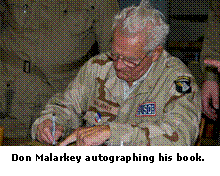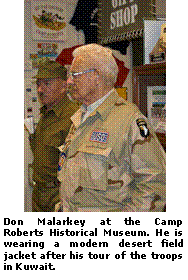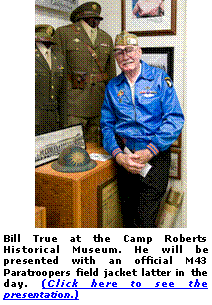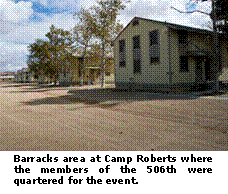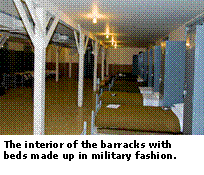|
On October 4-5, 2008, I had the privilege of once again spending a weekend with the reenactors of the 506th Parachute Infantry Regiment (PIR), Second Battalion of the 101st Airborne Division. I can’t say enough to express my respect and admiration of these men. They devote a great deal of time and treasure to preserve our military history. To them their “Impression” is paramount. By Impression, I mean the authenticity of the uniforms they wear and the military gear they use. To a casual observer stumbling upon their encampment one would feel they had entered a time machine and traveled back 65 years to 1943 and World War II. Even the meals they eat come from authentic K-Ration packs. They use real weapons and blank ammunition. The 506th PIR is a member of the WWII Research and Preservation Society.
The World War II Research and Preservation Society (WWII RPS) is a California non-profit corporation that has been active in historical research and Living History Reenacting for over a decade. Members come from all walks of life, ranging from active military duty & retired military personnel, law enforcement , doctors, lawyers, artists, students, and business executives...all with a passion for World War II history and a common goal of preserving our nation's part in that war. Part of that preservation entails depicting not only U.S. soldiers from that era, but also their Allies as well as their opponents.
They are comprised of member "Units" that are based on actual World War II units. Extensive historical research goes into the study of these units. A tremendous amount of effort and resources go into building an individual soldier's "Impression". The construction of one's impression can be a fun and rewarding process and can literally take years to perfect.
This recent reenactment event was dedicated to the airborne assault of the 506th in the early morning hours of 6 June 1944 on the flooded fields of the Cotentin Peninsula in Normandie, France. This meant leaving the barracks of Camp Roberts, California at 0400 hours on trucks and being taken in the dark of night to the wooded areas surrounding the camp. To make the exercise as realistic as possible the men were scattered over a three-mile area in the dark of night and given the mission of joining up with other members of the company. Of course, there were reenactors portraying German defenders who were trying to capture or kill them.
To make this event even more special the reenactors were joined by five veterans of the 506th from Easy and Fox Companies. These vets made the real drop on the morning of 6 June. The vets were Bob Noody, Bob Janes, and Bill True of Fox Company and Don Malarkey and Ed Pepping of Easy Company. If you watched the HBO miniseries “Band of Brothers” Don Malarkey (played by Scott Grimes) was one of the major characters in the series. Don won a Bronze Star for his action at Brécourt Manor, where Easy Company destroyed four German 105mm guns that were shelling the Fourth Division on Utah Beach.
The participation of these veterans means a great deal to these reenactors. They love the stories they tell and make an effort to video tape their accounts of the period. This adds quite a bit to the preservation of the oral history from the members of the “Greatest Generation”. These vets will contend that every generation in America is the greatest, especially those men and women serving their county in today’s War on Terror. |
|
Fred Henstridge Photography joins the Reenactors from the 506th PIR/Second Battalion to reenact the D-DAY night drop at Camp Roberts. |
|
If you are having problems viewing this page or the graphics please Click Here or to visit our Blog Click Here. To view my galleries of geo-referenced photos from around the world Click Here. To view additional galleries Click Here. |

|
To remove your name from our mailing list, please click here. Questions or comments? Email us at fhenstridge@henstridgephotography.com or call 951-679-3530 To view as a Web Page Click Here. Please visit our Web Site at http://henstridgephotography.com. |
|
Volume 1, Issue 2, October, 2008 |
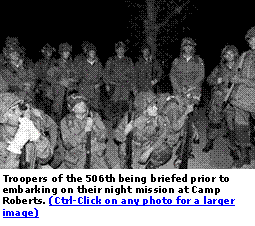

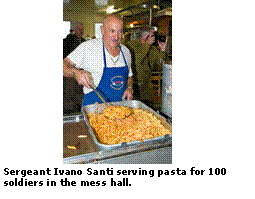

|
THE VETERANS |
|
BOB JANES
Bob Janes was drafted on February 24, 1942 and volunteered for the paratroopers. After his basic training he was assigned to Fox Company, 2nd Battalion, 506th PIR of the 101st Airborne Division at Camp Taccoa, GA. Bob Janes was drafted on February 24, 1942 and volunteered for the paratroopers. After his basic training he was assigned to “Fox” Company, 2nd Battalion, 506th PIR of the 101st Airborne Division at Camp Taccoa, GA. Like all of the other members of the 506th he ran many times up and down Curahee Mountain. He crawled under barbed wire and through muddy ditches filled with rotting animal carcasses with the bullets from live machine gun file whistling several feet over his head. To make things even more interesting there were live explosive devices scatted throughout the site. Some say that the training was as terrifying as the actual combat.
Bob dropped on to the town of Sainte Mére Eglise some 45 minutes before the arrival of the troopers from the 505th PIR of the 82nd Airborne Division. Attaining the rank of Staff Sergeant Bob fought with the 506th all through Normandie, Holland and was with the 506th in the frozen hills of the Ardennes Forest at Bastogne. During his tenure with the 506th he earned a Bronze Star, Purple Heart, 2 Presidential Unit Citations and the French Croix de guerre.
Like most of the returning veterans from WWII Bob took advantage of the GI Bill to obtain a college education. Bob believes that this Bill was one of the best things this nation ever did for returning war veterans. It provided an advanced education for many men and women that would not otherwise been able to afford one. It produced the engineers, scientists, teachers, doctors and business leaders that contributed so much toward building this nation. Bob now resides with his wife, Nadene in Hood River, Oregon.
ED “DOC” PEPPING
Ed, a talented musician, was a member of the Pasadena Symphony Orchestra and an avid opera fan before the war. He enlisted in September, 1942 and like the other members of the 506th he volunteered for the paratroopers. After his basic training he was assigned to the “Easy” Company, 2nd Battalion, 506th PIR of the 101st Airborne Division at Camp Taccoa, GA. Ed like to note that he ran up and down Curahee Mountain some 33 times amounting to a total of 198 miles. While the third best marksman in his Company Ed volunteered for a Medical Detachment where he became the company’s medic. Ed had doubts as to whether or not he would be able kill someone and believed he could serve his nation and his fellow troopers better by saving lives.
When the C-47 carrying Ed and the other 17 troopers arrived over the Sainte Mére Eglise drop zone they should have been flying about 700 feet above the ground at a speed of 95 miles per hour. In fact, due to the German flak and the evasive maneuvers of the pilots, they were doing 160 MPH at just over 300 feet. When Ed jumped the force of the high speed air racing by the plane forced his medical gear off of his body and when he hit the ground he had 3 cracked vertebrae.
Ed continued to serve in the field administering to the needs of the wounded trooper for fifteen days until he finally collapsed during the assault on Carentan and was evacuated to England. During the time Ed received the Bronze Star for pulling a wounded officer from a tank turret where he been shot and fallen on top of the tank commander. This had caused the tank to stop and halt the movement of the entire column subjecting them to German fire. ED climbed up on the tank, and under fire, pulled the wounded man to safety allowing the column to proceed. This action took place at a crossroads nicknamed “Dead Mans Corner” just outside of Sainte Marie du Mont.
Ed returned to France after his wounds healed and resumed his duties as a Medic. He believed it was an honor to serve in a hospital extreme trauma ward where he could tend to the most seriously wounded. During his tenure with the 506th he earned a Bronze Star, Purple Heart, 2 Presidential Unit Citations and the French Croix de guerre. He also received the Army's Legion of Merit medal and is a holder of the Combat Medic and Combat Infantry Badge. Ed now resides in Whittier, California.
DON MALARKEY
Don a gifted high school athlete was drafted in September, 1942. After volunteering for the paratroopers Don was shipped to Camp Taccoa, GA where he became a member of "Easy" Company, 2nd Battalion, 506th PIR of the 101st Airborne Division. He went to England in 1943 to participate in the largest amphibious invasion in history: D-Day. In the darkness of the morning of D-Day, Malarkey parachuted into France with his unit. Later that day, he received the Bronze Star for his heroism in a pitched battle to knock out a German 105 mm artillery battery, an action now called the Brécourt Manor Assault. Easy Company’s capture of the German battery at Brécourt became a Text Book Example of an assault on a fixed position and is still demonstrated at the U.S. Military Academy at West Point.
In the HBO miniseries Band of Brothers, Don Malarkey was portrayed by the actor Scott Grimms. Throughout the series there were many instances where Don’s was portrayed. This is no doubt due to the fact that Don fought in every engagement that Easy Company was involved. He fought for twenty-three days in Normandy, nearly eighty in Holland, thirty-nine in the Battle of Bastogne in Belgium, and nearly thirty more in and around Haugenau, France, and the Ruhr Pocket in Germany. He was promoted to sergeant before Operation Market Garden. Never seriously wounded, Malarkey served more time on the front lines than any other member of Easy Company.
After the war Don returned to Oregon and received a degree in business. Shortly after his graduation he married his beloved wife Irene and moved to Portland , Oregon. In 1987, Don was introduced to author and University of New Orleans Professor of History Stephen Ambrose at an Easy Company reunion. In 1989, Don traveled with Ambrose and other members of Easy Company, including Richard Winters and Carwood Lipton, to various sites where they had fought in Europe following the D-Day invasion. The oral history and first person recollections that Malarkey and the others provided became the basis for Ambrose's book Band of Brothers, which was published in 1992.
Don lives in Salem, Oregon and travels and speaks extensively to high school and college students and other groups on his Easy Company experiences. He has traveled to Army bases and hospitals in the United States and Europe, where he has met with soldiers wounded in the Iraq War. Malarkey's autobiography, Easy Company Soldier: The Legendary Combat of a Sergeant from World War II's "Band of Brothers", was published in May 2008 by St. Martin’s Press.
BILL TRUE
Bill True enlisted in the U.S. Army in August, 1942 in San Diego, California. After volunteering for the paratroopers Bill was shipped to Camp Taccoa, GA where he became a member of "Fox" Company, 2nd Battalion, 506th PIR of the 101st Airborne Division. Shipped off to England with the rest of the members of the 506th Bill dropped into the Norman countryside behind Utah Beach in the early morning hours of 6 June 1944. In Bill’s own words taken from the dust jacket of his book “The Cow Spoke French” bill states: “As I exit, artillery fire and tracer bullets fill the sky. It’s 1:20 AM on a bright moonlit night I land hard in the middle of a farm field next to a placid cow, chewing her cud: a welcome sight indeed. I mutter a thankful greeting to her as I scramble from my harness, but she does not respond. Why not? Because the cow spoke French.”
The comment quoted above shows some of the humor in Bill’s book, but don’t be fooled. Bill tells the story of the harsh reality of ground warfare in Europe. Everything from the hours of boredom and hard labor to the moments of sheer terror are covered.
Bill served with the 506th from Normandie, through Holland, Bastogne all the way to Hitler’s retreat in Berchtesgaden. He attained the rank of Sergeant and earned the Bronze Star with Oak Leaf Cluster, Purple Heart, 2 Presidential Unit Citations and the French Croix de guerre. Bill now resides in Port Hueneme, California. |
|
Camp Roberts |
|
The reenactors were allowed to use the barracks, mess hall and grounds Camp Roberts, California. Construction of the main garrison area began November 15, 1940 after Congress authorized the funds to lease Ranch Nacimiento and five adjoining ranches. Ultimately over 8,000 workers were involved in the construction of a training site capable of housing 30,000 trainees at one time. During WWII 436,000 troops passed through Camp Roberts. During the Korean War another 300,000 troops were trained here. Some of the notables that passed through the Camp were: Robert Mitchum, Steeve “Hercules” Reeves, and comedy legend Red Skelton.
During construction it was decided to change the original name, Camp Nacimiento, to Camp Roberts in honor of 18-year old Corporal Harold W. Roberts, a World War I tank driver from San Francisco who had died in France and been awarded the Medal of Honor. Today Camp Roberts is the only military post still named for an enlisted person.
The US Army officially closed the Camp in April 1970 and on April 2, 1971 the California Army National Guard received control of the Camp. Today military units from all services branches (and some foreign countries) continue to train here. National Guard units are still processed through Camp Roberts to be deployed throughout the Middle East and Eastern Europe in the War on Terror.
I have included some photos in the gallery linked to this newsletter to show the extreme state of disrepair that has overcome this Camp. Barracks are rundown and in disrepair, the latrines are filthy and the grounds look terrible. It is deplorable that the State of California can ask its sons and daughters to fight in the War on Terror, respond to natural disasters and keep the peace when needed to ask them to train and deploy from such a rundown and ill functioning facility. It is a tribute to the reenactors that when they come to a camp such as this, they leave it in better shape than when they arrived.
|
|
Closing Thoughts |
|
To participate with these reenactors as a photographer is always an honor for me. Through their continuing efforts and dedication, they keep our military history alive and honor those who did not come home from WWII. Click Here to entry the gallery of photos from this event. May God bless all of these men and women who preserve our history. |
|
BOB NOODY:
Bob Noody wanted to become a Franciscan Priest but was drafted in February of 1943 and volunteered for the paratroopers with the lure of an additional $50.00 per month. After his basic training he was assigned to the 2nd Battalion, Fox Company, 506th Parachute Infantry Regiment (PIR), 101st Airborne Division at Camp Taccoa, GA. It was at Camp Taccoa where the trainees of the 506th were required to run up and down the three mile trek up the 900 foot Curahee Mountain. This was part of the conditioning program that the paratroopers had to endure on an almost daily basis.
Bob was then shipped to Aldebourne, England with the rest of the regiment where they underwent more training. Finally on the night of 5 June they were loaded into Army C-47 transport planes and took off for Normandie, France. (add photo here). Around 0200 hours on the morning of 6 June, after encountering heavy German antiaircraft fire, they reached their drop zone over Sainte Mére Eglise, France. The troopers were loaded down with 100 pounds of equipment, which many lost during the jump. It is interesting to note that the troopers of the 506th arrived over Sainte Mére Eglise almost 45 minutes prior to the 82nd Airborne, which was credited for the liberation of the town.
Bob continued to fight through Normandie and it was during the assault on Carentan where he was awarded a Bronze Star with Oak Leaf Cluster for knocking out a German tank with a bazooka. Bob eventually earned the rank of Sergeant and went on to fight in Holland (Operation Market Garden) and Bastogne (Battle of the Bulge). He stayed with the 506th until the end of the war. Besides the Bronze Star Bob earned two Purple Hearts, 2 Presidential Unit Citations and the French Croix de guerre. Bob now resides with his wife Elizabeth, in upstate New York. Bob told me that she never knew he was a paratrooper until she saw his photo in a magazine article some years after the war.
|

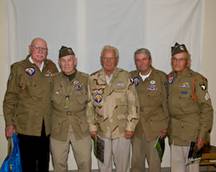
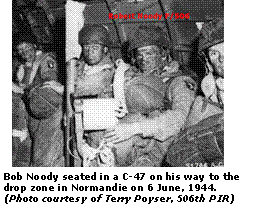

|
Bob Janes in his M41 paratrooper field jacket. This photo was taken during a tour of the Camp Roberts Historical Museum. |
|
The five veterans of 2nd Battalion, 506th PIR. (Click on photo for a captioned image) |

